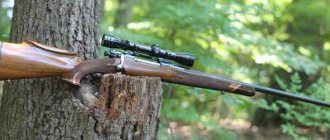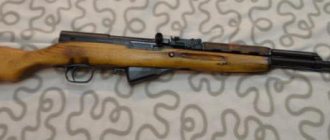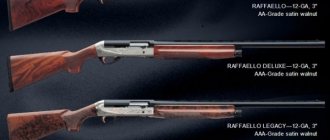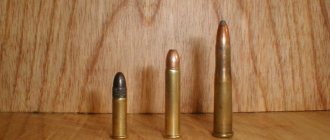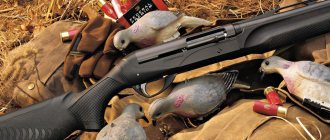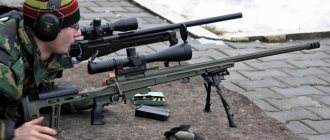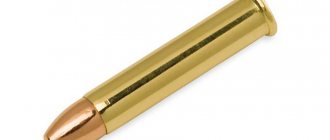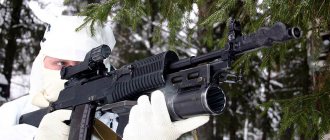Small arms in Belgium are produced at the State Enterprise in Erstal (also called “FN Erstal”), founded in 1889 for the production of Mauser rifles. Thanks to a very fruitful collaboration with the American gunsmith designer John Moses Browning, FN Erstal produced some of the most famous pistols in the world and have been in service for quite a long time, including the FN Browning High Power, which was designed back in the first decade of the 20th century. . Even in the first decade of the 21st century. Imitations of this pistol are in service with many armies, including the British.
Pieper Bayard, 1908
This compact pistol was designed by Bernard Clarus, designer (AEP), as an imitation of the Browning system. In it, Clarus also embodied his own ideas, changing the design of the trigger and sear and placing the sear in the bolt behind the trigger. Under the influence of recoil, the bolt, hammer and sear simultaneously moved back, and the recoil energy was absorbed due to friction and resistance of the leaf spring. There were several versions of this pistol, but their dimensions were the same, although the calibers differed.
Pieper Bayard, 1923
This pistol, also designed by Bernard Clarus, was an imitation of the Browning Model 1910. It retained Clarus' innovations in hammer and sear design, as well as the placement of the sear in the slide behind the hammer. AEP was known for its Bayard pistols, production of which continued throughout the 1930s and ceased only after the occupation of Belgium by German troops at the beginning of World War II.
Clément, 1907
This pistol was designed by the Liege gunsmith Charles Clément and was a modification of his earlier and highly original design, which used a fixed barrel and a movable bolt. When the bolt moved back, it was slowed down by a return spring located above the barrel. The detachable magazine held six rounds. The pistol was also produced chambered for 6.35 mm caliber.
DESIGN OF THE BERGMANN M 1896 PISTOL
The pistol operates on the principle of using the recoil energy of a free shutter and is equipped with a fixed barrel. The bolt return spring is installed in the socket of the hollow bolt. The weapon is equipped with a revolver-type handle and a non-removable box-shaped stack-loading magazine located in front of the trigger. To reload the weapon, open the magazine cover down and insert a new pack of 5 rounds into the magazine groove. After closing the magazine lid, a spring-loaded feeder begins to act on the lower cartridge, squeezing the cartridges upward, where they are intercepted and sent into the chamber by the bolt.
The pack itself can be left inside the magazine or removed through a slot in the lid by pulling the ring, which remains sticking out outside under the magazine after its lid is closed.
It was believed that this weapon should perform equally well both with the pack removed and with the pack left in, however, from reports at the time it is clear that when the pack is removed from the magazine, the cartridges are too loose and often distorted when fed.
FN Browning M1900
This single action pistol was designed by John Browning in 1898 specifically for the Belgian . The Model 1900 was a slightly modified version with a shorter barrel. The success of this model is evidenced by the fact that by 1911 at least 700,000 were produced. One of the reasons for its success was the amazing simplicity of the design, which significantly reduced the number of production and assembly operations. A special feature of the pistol was a return spring located above the barrel, which acted on the bolt through a special lever.
This model is known by several names, including "FN M1900", "FN Model 1900", "Browning M1900" and "Browning No. 1".
Belgian arms manufacturers
A huge number of factories in Belgium produce high-quality Belgian guns. Let's consider the most popular and widely known companies:
- State Factory (abbreviated as FN). Located in the city of Erstal, which is located near Liege. It produces 90% of hunting weapons in all of Belgium. The company produces serial models that include self-loading, smoothbore shotguns and double-barreled shotguns with vertical barrels. Known as "Brownings", named after the master who made them, John Browning.
- "Dumulin." This factory produces mainly hunting rifles and rifles with a horizontal barrel.
- "Lebo-Kuralli". One of the revered companies, founded in 1865. The first guns it produced were produced under the August Lebeau brand. Thanks to the masters of their craft, original works appeared, which, in their quality, were in no way inferior to their English counterparts of the highest class. Such Belgian guns were highly valued even outside the country. For example, in Russia, the presence of this model in a gun store was considered prestigious, and therefore many owners tried to get at least one copy for their sales premises.
- "Augustus Francotte". They were also highly valued among us. These models were produced in several variations, from cheaper models to the most expensive.
Unfortunately, in the early forties, a huge amount of Belgian weapons were confiscated by representatives of the NKVD and sent for melting down, so most of the first models of hunting weapons did not survive to this day.
FN Browning M1910
The pistol was a further development of the 1900 and 1903 models. This classic design remained in production almost uninterrupted until 1983. The Model 1910 featured a recoil spring around the barrel, giving the weapon a different appearance than previous models. In addition to the manual safety on the left side of the M1910 body, there was also an automatic safety on the back of the handle. Relatively light and small, this pistol was often used as a sidearm and was also in service with several armies.
Using the FN Browning M1910 pistol, Tavrilo Princip shot and killed the Austrian Archduke Ferdinand in Sarajevo on June 28, 1914.
Advantages and disadvantages
First, let's talk about the positive aspects that the Belgian submachine gun can boast of:
- The main advantage is innovative ergonomics with very compact dimensions and low weight. The PP is easy to learn for right-handers and left-handers (used cartridges are ejected from below so as not to hit the shooter’s face, regardless of which shoulder the shooting is fired from);
- Outperforms analogue models of “pistol” calibers (9*19 mm, .45) in terms of accuracy and shooting accuracy, while having relatively low recoil;
- The P90 combines a high rate of fire with a large magazine capacity. For the convenience of the shooter, the magazines are made of transparent plastic, so the fighter always knows how many cartridges are left in the magazine;
- At short distances the bullet has excellent armor-piercing properties.
Now about the cons:
- Doubtful lethality;
- The complex design of the reloading process and the general unreliability of the magazine;
- High production cost: one P90 is equal in price to approximately three “classic” assault rifles or 5-7 Uzi SMGs.
The photo shows a fighter of the Austrian Jagdkommando
FN Browning M1922
The Model 1922 featured a longer barrel and bolt.
A removable sleeve about 20 mm long was attached to the front of the bolt with a Browning 1922 model bayonet connection. It was the result of further development of the 1910 model. The barrel became longer, which increased shooting accuracy and muzzle velocity. The frame size and shutter length have increased. The bolt was lengthened by adding a detachable sleeve at the front. The 1922 model was widely used by army and police units of European countries, including the armies of Greece, Turkey, France and Yugoslavia. During the period between the two world wars, this pistol became a very popular police, military and civilian weapon in Europe. It continued to be produced during World War II, with several hundred thousand being made for the German army during the German occupation of Belgium. The unusually long series production of this successful model continued until 1983. The United States imported both models, M1910 and M1922, under the name "Browning 380" chambered for the .380 AKP cartridge. After 1971, these pistols began to be equipped with adjustable sporting-style rear sights and larger grips to bring them into compliance with US gun laws.
These models began to be equipped with an automatic safety on the handle to prevent an accidental discharge, in particular when the weapon was dropped.
Combat revolver
Launched into production in 1895, the revolver quickly began to enter the army. It was first used in close combat by Lieutenant Stankevich from the 12th Siberian Regiment during the “Boxer Rebellion” in China in 1900. He was able to shoot several Chinese soldiers who were moving toward the officer in hand-to-hand combat.
Hero V. Vysotsky detective Gleb Zheglov shoots from a Nagant
Source: kinopoisk.ru
Nagan also performed well during the Russo-Japanese War. Comfortable and unpretentious, he gained respect among officers and soldiers. Then, in the First World War, in brutal trench battles, the revolver was distinguished by its reliability; it was not scary to drop it in sand or mud, or shoot in the rain or dust. The Nagan simply did not misfire, even if the next cartridge did not fire, they simply fired the next one.
Then the shortcomings also appeared. The large wrist reinforcement when shooting with self-cocking led to the fact that after 3-4 fired drums the shooter’s hand became very tired. Slow reloading of the revolver, one spent cartridge case and one new cartridge, was also noted. At the same time, the “soldier’s” versions received negative reviews: it was inconvenient to cock the revolver every time, especially if in close combat you had to use a cold weapon with the other hand, while “officer” revolvers could be fired Macedonian style with both hands (this effective technique is very loved by the creators of action films and TV series).
A. Kuznetsov's hero, Red Army soldier Fyodor Sukhov, was also armed with a Nagant
Source: pikabu.ru
The Nagan became a symbol of revolutions in Russia. Despite the fact that army officers, police officers, underground fighters, and revolutionary terrorists had access to more modern and fast-firing pistols (primarily Brownings and Colts), many often carried a second barrel with them, and they had a trouble-free revolver. If the pistol jammed or misfired, the revolver was used, and often saved the life of its owner. During the Civil War and after it, the revolver became a weapon in the fight against criminal elements and gangs (however, the bandits themselves and anti-Soviet elements also loved this revolver). The Nagan could easily and for a long time be stored in hiding places, caches, or simply under the floor, and when removed it was immediately ready for use.
FN Browning Baby
This pistol, based on the compact Model 1906, was officially produced in 1932. It is easily recognized by its angular appearance, which is defined by a frame the same length as the slide. The sights are permanent. Early issues can be identified by the name "Baby" engraved on both sides of the handle at the base. This option does not have an automatic safety on the handle, but does have a manual safety under the handle. Usually the Baby pistol was fired with both hands wrapped around it, since the recoil was very strong. It was first imported into the United States in 1954.
Performance characteristics
The table will help you easily compare the characteristics of all Browning models. Explanation of abbreviations used in the table is below it.
| Model | M1900 | M1903 | M1906 | FN Model 1910 | M1910/22 | hp35 |
| Length, mm | 164 | 203 | 102 | 153 | 178 | 200 |
| Barrel length, mm | 102 | 128 | 53,5 | 88 | 113 | 118 |
| Weight, gram | 625 | 910 | 380 | 590 | 700 | 885 |
| Cartridge, mm | 7,65×17 | 9×20 | 6,35×15,5 | 7.65×17 and 9×17 | 7.65×17 and 9×17 | 9×19 |
| Principle of operation | NW | NW | NW | NW | NW | OSKH |
| Cartridges in the store | 7 | 7 or 10 | 6 | 7 or 6 | 9 or 8 | 13 |
| Aim | HP | HP | HP | HP | HP or P | HP or P |
SZ - free shutter.
OSKH - barrel recoil during a short stroke.
NR - non-adjustable sight, R - adjustable.
FN Browning High Power M1935 (Grand Puissance 35)
The Model 1935 9mm "High Power" pistol was John's last design. After his death in 1926, the pistol was accepted for production, but release was delayed until 1935. The success of this pistol was so great that that after the German invasion of Belgium it was adopted by the German army, and also penetrated into Great Britain, Canada and China. In 1954 it became the service pistol of the British Army. Even in the 21st century. The Browning M1935 continues to be the service weapon of the Belgian army and police, the British army and many law enforcement organizations. In terms of length of service as a service pistol, it is second only to the Colt M1911, also designed by Browning. In the UK they are proposing to replace this weapon, since the 9mm Parabellum cartridge is no longer effective against the latest body armor.
Despite its age and the many copies and imitations produced, Browning High Power is still in production today.
Brand
In the production of Belgian hunting rifles, much attention was paid to the mark. They began to brand it in the 17th century, even at a time when weapons were made by handicraft. This was done so that every knowledgeable person could see whether this or that gun was of high quality or not. Since all gunsmiths had different levels of ability, the quality and reliability of each differed.
In 1672, it was decided to correct this circumstance and it was decided that every Belgian gun must pass a test before it was put on sale. Those models that passed the test were branded by applying a drawing on it, which depicted a column on the city’s coat of arms.
Larger inspections began during the time of Napoleon in 1810. It was tested at a station built in Liege. Firearms that were not tested were not branded and were not allowed for sale.
Over time, new laws were issued that spoke of more careful and strict control over the quality of weapons produced. Thanks to this, they gained fame and became a standard among their brothers. Now these rules are used not only in Belgium, but also in other countries involved in the production of firearms.
FN Browning, Mk II
This is a remake of the Browning High Power, one of the classic pistols of all time. Although the model was significantly modernized compared to the prototype (a new handle and a double-sided manual safety appeared), the improvements made were not enough for the model to compete with modern pistols that have filled the arms market. The pistol tried to sit between two chairs - the classic High Power and a completely new model. As a result, its production lasted a relatively short time - from 1980 to 1987.
Ammunition for Browning models
In 1899, John Browning developed the 7.65x17mm cartridge for his first pistol. It is used for civilian semi-automatic weapons to this day.
Soviet-made 7.65 mm Browning cartridge
Browning M1903 is loaded with 9x20 mm cartridges. For the ladies' Browning M1906, the designer created a 6.35x15 mm Browning cartridge weighing 5.2 g, which is also produced in a number of countries to this day.
High Power Browning requires the owner to purchase 9x19mm Parabellum ammunition.
What do you think about the Browning pistol? What is your assessment of the first compact weapon? Did you have to shoot them and maybe buy them? Share your thoughts and experiences in the comments, your opinion is important to us.
FN Browning, Mk III
The changes that produced the Browning Mk III in the 1990s finally did justice to the pistol some consider the most famous in the world. Although there are few external differences between the Mk II and Mk III, the manufacturing process has been improved. There are small but noticeable differences in dimensions. The handle has become more ergonomic. This model, developed according to the original “High Power” design, featured large manual safety levers on both sides of the body, an open trigger, an automatic firing pin safety and a magazine safety that prevented the trigger from being released when the magazine was removed. The sighting devices have been slightly changed, making it easier to quickly aim.
combines computer technology and classical designs to produce the most competitive weapons.
A little history
The production of guns in Belgium began in the 17th century. At first they were sold within the country, and only after some time they began to be sold abroad. At first the batches were small, but as they gained popularity they began to grow. It is known that in 1860 Belgium was able to sell weapons worth 11,891,960 francs. There are a lot of countries to which goods were exported. Russia is only in thirteenth place on this list. The top ten are headed by:
- Chile.
- England.
- Prussia.
- France.
Belgium now also sells a large number of weapons both at home and abroad.
FN BDA 380
This pistol, intended for police and civilian use, appeared in the early 1980s. The weapons were made in Italy under a contract with. This is a double action blowback pistol with an ambidextrous manual safety on the slide. When on, the safety disconnects the trigger and hammer. The BDA 380 pistol was adopted by the Belgian police. Despite the good reputation of this weapon, its production was discontinued in 1997.
Bergmann pistols. Germany-Belgium
The famous German engineer Theodor Bergman is considered one of the first designers of automatic pistols in Europe. Although, according to some sources, he was, like the American Samuel Colt, just a fairly successful entrepreneur who more or less successfully used the ideas of hired engineers.
The first pistol in Bergman's name was patented in 1892. The co-author of this patent is Otto Brauswetter, a watchmaker from the Hungarian city of Szeged. This weapon, operating on the principle of recoil of the barrel during its long stroke, turned out to be not very successful.
In 1893, a more advanced model appeared, bearing the name of Bergman. This was a weapon with a semi-free bolt, the opening of which was slowed down by self-braking when moving along inclined slats. This weapon had the main feature of all Bergman pistols: a magazine located, like the later Mauser C 96 pistols, in front of the trigger guard. Caliber - 7.62 mm. In 1994, this weapon, converted to a 6.5 mm cartridge, was submitted to the Swiss army for testing, but was rejected.
Bergmann M1894 pistol
Bergman decided to abandon the semi-blowback action, moving to a simpler blowback action design. This is how the 1894 model appeared, patented jointly with Louis Schmeiser. A noticeable feature of this weapon was the absence of flanges or grooves on the ammunition casings intended for extraction. The pistol did not have an extractor at all; spent cartridges were extracted by the residual pressure of the powder gases. When the cartridge case moved back along with the bolt, the cartridge case “bumped” into the reflector and flew out of the receiver. Strange, but this system worked quite well, although, naturally, there were some delays.
Several modifications of this pistol were created for Bergman cartridges of 5 mm, 6.5 mm and 8 mm calibers, as well as for the Swiss Schmidt revolver cartridge of 7.5 mm caliber. The pocket model of 5 mm caliber caused a big sensation in the gun world: it was an unprecedentedly small and simple weapon for its class, which had a unique folding trigger. Also in 1894, a 6.5 mm modification of the Bergman pistol mod. 1894
The tests were quite successful: a pistol bullet with an initial speed of 236 m/s entered a pine log at a distance of 6 m at 148 mm, and also pierced a layer of tin sheets 9.9 mm thick. Swiss revolver Schmidt mod. 1882 gave much worse results: 215 m/s, 92 mm and 3.6 mm, respectively. However, this weapon was never put into service and did not sell as well as we would like on the civilian market.
FN BDA (Browning double action)
This pistol, produced in the 1990s, was made according to the Browning High Power design. Basically the mechanism remains the same. The most significant differences were the double-action trigger mechanism and a device for safely decocking the hammer, which replaced the safety latch. The levers of this device are located on both sides of the body and can be operated with either hand. The most distinctive feature of the BDA was the large safety guard. The next model of this weapon was the BDAO, intended for law enforcement organizations. The trigger mechanism on this model has been modified to prevent accidental discharge.
Belgian 12 gauge shotguns
Among smoothbore shotguns, 12 gauge is especially popular. This is because this model is easier to handle. You can easily handle the size of the powder charge. There are also no restrictions when choosing a charge: bullets, buckshot, shot. Any types and numbers can be used.
Among the Belgian 12 gauge shotguns, the following models are widely known:
- "Walrein" ("Legrand"). This type is famous for its high quality steel.
- "Grand Rus". A distinctive feature is the fine engraving that completely covers the block.
- "Prince Albert" Minimal engraving applied to the sides of the boards.
- "Count Kodashev" Weapons with small patterns in the English style.
- "The Parisian Count". It has one escapement and a wide reinforced strap.
- "Colorado". Also has one descent. The rounded block is covered with a small pattern.
- "Boss Verre." Low-set barrel and small block. This model was released in memory of the late J. Verne. He ruled the company until 1982.
These are the most popular and widely known models of this caliber.
FN Browning High Power
"High Power" .40 caliber was produced for the civilian weapons market. The bolt was redesigned and strengthened to accommodate a more powerful cartridge, and the magazine capacity was reduced to ten rounds. To fire .40 caliber cartridges, you can only use High Power, specially designed for them. Like other Browning pistols, this pistol used the recoil energy of the barrel and a locked bolt. Engagement was carried out using protrusions on the breech of the barrel and on the inner surface of the bolt according to a scheme invented by John Browning. Single action trigger mechanism with open trigger.
Collette repeating pistol (Belgium)
As you know, small arms of past centuries needed a long reload after each shot.
This did not suit the shooters, as a result of which original weapon designs with one or another means of ammunition supply were regularly proposed, which made it possible to fire several shots in a row with minimal manipulation between them. Subsequently, the ammunition supply devices were supplemented with automatic reloading and cocking systems. An interesting version of a repeating pistol, capable of firing two dozen shots in a row, was proposed by the Belgian company Collette. By the middle of the 19th century, it became clear that the further development of small arms would be associated precisely with the creation of integrated means of storing and supplying ammunition. A direct consequence of this was the emergence of a mass of new original projects that proposed one or another way to increase the practical capabilities of weapons. For obvious reasons, almost all such projects involved the use of new and unusual ideas, which were tested in practice using ready-made weapons.
In the early fifties of the century before last, Belgian gunsmiths working at the Victor Collette factory (Liège) took up the topic of magazine weapons. As far as we know, the main contribution to the creation of the new project was made by the owner of the enterprise and designer Herman Jean Nicolas. They completed the design in 1853 and then applied for a patent. Subsequently, the first samples of promising weapons were manufactured, which were to become exhibition samples. The first public display of the Collette pistol took place in 1855 at the World Exhibition in Paris.
As far as we know, the original project of a repeating pistol never received its own name. This weapon is referred to in various sources as the Collette System or the Collette Pistol. In addition, the name is known, indicating the principle of operation of the ammunition - Collette Gravity Pistol.
The main objective of the new project was to create a relatively light and compact weapon, equipped with means of storing and supplying ammunition. To achieve such goals, the project planned to apply several interesting solutions of one kind or another. As a result, the finished pistol could look similar to existing models, but had the most noticeable differences, both in exterior and in design.
The new Collette pistol had a general appearance that was generally consistent with the “fashion” of its time. All units were mounted on a compact metal frame, the upper part of which had a seat for the barrel and magazine. A curved handle was attached to the frame at the back. All ammunition supplies were secured outside the frame; it contained only the parts of the trigger mechanism.
It should be noted that the Collette-Nicolas pistol was distinguished by the open arrangement of a number of important parts, which to a certain extent limited its resistance to contamination. However, this product was not considered as a weapon for the army. It was planned to be introduced to the civilian market and offered to amateur shooters. Using the pistol exclusively at equipped shooting ranges made it possible to avoid a lot of problems caused by the open placement of units.
The frame of the pistol was distinguished by the simplicity of its external contours. It had an increasing cross-section, close to rectangular. Its rear part, equipped with mounts for the handle, was distinguished by its increased dimensions. The top of the frame was intended to accommodate the barrel, behind which there were slots for the bolt and trigger. A trigger guard was attached to the bottom of the frame. To bring the latter out there was a corresponding slot. At the top and bottom of the back of the frame there were large curved protrusions, with the help of which it was proposed to be connected to the handle.
One of the largest units of the Collette “gravity” pistol was the barrel. It was made in the form of a large elongation part with an octagonal cross-section over most of its length. In the breech section the cross-section smoothly turned into a rectangular one. The barrel had a rifled bore with a caliber of 10.16 mm (0.4 in) and a length of 228.6 mm (22.5 cal).
A magazine of an original design was placed on the top of the barrel. Its main detail was an inverted trench-cover, mounted on small racks above the barrel. At the front, this groove was in contact with the upper influx of the barrel. The latter provided a round hole with a spring-loaded lid, necessary for equipping the store. At the rear, the magazine cover had a hinge for installing a swinging round guide with a hinged lock. The guide and lock were connected to the bolt.
The repeating pistol had to use special ammunition. V. Collet and E.J. Nicolas chose a caseless .40 caliber cartridge. This product was a low elongation bullet, in the rear part of which there was a relatively large cavity. This volume was intended to load propellant and ignition charges. When fired, the entire “cartridge” under the influence of powder gases completely left the barrel, without leaving any of its elements in the chamber. This feature of the ammunition greatly simplified the design of a repeating pistol.
An original shutter design was proposed. The shutter itself was made in the form of a vertically located movable rectangular plate with several protrusions at the top. Its upper part was thicker. The front part of this element had a chamber of the required dimensions, behind which there was a through channel for the firing pin. On the rear outer surface of the bolt there was a vertical groove for the trigger to fit into. The lower, thinner element of the bolt had only a round hole that corresponded to the caliber of the barrel. There was a simple system to fix the bolt in the correct position and prevent it from moving to the side. A small spike was placed on the frame, which went into a vertical hole in the lower part of the shutter. When moving down, the latter was automatically centered.
The upper protrusions of the bolt were hingedly connected to the swinging magazine guide. Its lower part, in turn, interacted with the corresponding rods of the trigger mechanism. The first mechanical link was used in the ammunition supply system, while the lower one was used when reloading and cocking weapons.
The Collette pistol's trigger mechanism was similar to systems used in single-action revolvers. A large swinging trigger protruded from the frame at the top. On its front surface there was a striker of sufficient length, on the back there was a large finger grip. Approximately at the level of the trigger axis, under the frame, there was a trigger. The internal parts of the trigger had a connection not only with each other, but also with the shutter. So, when cocking the hammer, the bolt had to move, which ensured that the cartridge was prepared for firing. The trigger received a protective guard with a protruding rear element.
[center]
Bolt and trigger. The shutter plate is in an intermediate position. Having gone up, she will be able to accept ammunition. Photo Jamesdjulia.com
The Collette-Nicolas pistol received the simplest sighting devices. In front of the magazine cover groove there was a small vertical front sight. The back of this cover, next to the guide hinge, was curved upward and had a rear sight slot.
The weapon received a wooden handle of a complex curved shape, in keeping with the fashion of its time. There were longitudinal grooves or notches on the side surfaces of the handle. Also, the wooden part of the pistols was decorated with carvings. In its ergonomics, the magazine pistol was similar to single-shot samples of previous models, which were widespread in the first half of the 19th century.
The Collette System pistol had an original operating principle, some of the features of which were reflected in one of the names. Indeed, in the process of preparing for a shot, gravity played a big role - without it, the cartridge would not have been able to get into the chamber, and new ammunition would not have reached the chambering position.
FN Five-North
The pistol was developed in the 1990s, taking into account the conditions of modern combat operations, chambered in a 5.7 mm caliber cartridge, capable of penetrating the latest types of body armor. The pistol is extremely light due to the use of modern synthetic materials in its design. The recoil is very low, which improves the accuracy of subsequent shots. The magazine holds 20 rounds. The Five-Seven design ensures complete safety thanks to the use of a double-action impact mechanism. The pistol looks very streamlined and has very few protruding parts. It can be used to mount a laser sight or a tactical flashlight.
Belgian 16 gauge shotguns
Among these models of firearms, the Browning Auto 5 is very popular and famous. This model was developed in 1898, but weapons of this type were not immediately produced, since most arms companies believed that 16-gauge guns were not promising and no one would buy them.
But the FN company did not succumb to pessimistic forecasts and began producing a new type of hunting rifle. The first ten thousand copies were sold in just one year. This model was extremely popular and was sold for a hundred years.
Depending on the year in which the model was released and the edition, the Browning was equipped with:
- trunks, both with and without sights;
- chokes (replaceable or fixed);
- trunks of different lengths;
- butts (semi-pistol or straight);
- Various finishes on the receiver and wooden parts.
In a word, the 16-gauge Browning has proven itself to be an excellent fighter, made of the highest quality steel. Thanks to this, it has excellent both ballistic and mechanical features.
Thus, Belgian weapons, due to their quality and reliability, have gained immense popularity among hunters and not only.
FN Browning PRO-9
This pistol, also known as the FNP-9, is designed as a police weapon. Its polymer frame is 30 percent lighter than steel. The easily removable trigger mechanism module is available in both double-action and self-cocking only. The first mode is designed for quick response, while the second provides greater safety by requiring more force when pulling the trigger. The cocked hammer is open. Under the ejector there is a red mark indicating the presence of a cartridge in the chamber. Interchangeable handle cheeks allow the owner to choose the most suitable shape.
Share link
(Belgium)
Pistol Clement M 1907
In 1907, the Belgian gunsmith from Liege Charles F. Clement proposed a new pocket automatic pistol, called the Clement M 1907. The Clement M 1907 model is a further development of the Clement pistol of the 1903 model. In general, the design of the Clement M 1907 is similar to the Clement M 1903, however, noticeable changes were made to the 1907 model.
- Weapons » Pistols » Belgium
Pistol Clement M 1912
In 1912, a gunsmith from Liege, Charles Ph. Clement, which created pocket pistols, offered a new compact pistol, the Clement M 1912. In this model, Clement abandoned his previously patented inventions in favor of a blowback design, very reminiscent of the Browning M 1906, but without a frame safety. The production of pistols began in 1912.
- Weapons » Pistols » Belgium
Pistol Clement M 1908
In 1907, the Belgian gunsmith Charles Ph. Clement proposed a pocket automatic pistol called the Clement M 1907. However, it did not receive commercial success (according to some experts, due to its poor appearance). In 1908, Clement modified his Model 1907 pistol and began producing a new pocket pistol, the Clement M 1908, chambered for 6.35 mm Browning, which received changes that were mainly of a “cosmetic” nature.
- Weapons » Pistols » Belgium
Bergmann Simplex pistol
In 1901, German gunsmith Theodor Bergmann patented a new pistol called the Bergmann Simplex (also known as the Bergmann M 1901), which was designed as a pocket pistol. Until 1904, the pistol was produced in small quantities at the German factory in Suhl. A number of these weapons were manufactured in Austria. In 1904, a Belgian company acquired a license for this weapon, which produced the Bergmann Simplex pistol in large quantities until 1914.
- Weapons » Pistols » Belgium
Pistol FN Fourty-Nine
At the end of the 1990s, the famous Belgian company Fabrique Nationale Herstal proposed a new pistol as a service and police weapon. Since this pistol was originally developed for cartridges of two calibers - .40 S&W and 9 mm Parabellum, it received the corresponding name “Fourty-Nine”. Although the pistol was created for the most popular cartridges, used large-capacity magazines and was lightweight, it could not compete with the new pistols created by the same company Fabrique Nationale and in 2008 production of the Fourty-Nine was discontinued.
- Weapons » Pistols » Belgium
Browning BDM pistol
In 1991, the American company, which is a division of the Belgian one, and using the Browning trademark, also owned by FN, created a new 9-mm pistol on the basis of the famous Belgian “High Power”, called BDM (Browning Double Mode). Although the Browning BDM was developed from High Power, it was created with significant changes. Both the design and construction of the pistol were subjected to improvements and modifications.
- Weapons » Pistols » Belgium
Pistol Clement M 1903
In 1903, a Belgian gunsmith from Liege, Charles Ph. Clement, patented a pocket pistol called the Clement M 1903. The pistol was originally designed for the Spanish “5 mm Charola-Anitua” cartridge, created for use in the Charola pistol. Since the Clement M 1903 pistol survived the design, and due to the successful sales of the Belgian pistol, the 5 mm cartridge also became known as the "5 mm Clement". However, in 1906, in connection with the creation of the 6.35 mm Browning cartridge for the FN Browning pocket pistol, the Clement M 1903 model was modified to accept the Browning cartridge.
- Weapons » Pistols » Belgium
Pistol FN FNP-45 / FNP-45 Tactical
In 2007, the American division of FNH USA of the Belgian company Fabrique Nationale Herstal (FN Herstal) announced a new pistol, the FNP-45, in the FNP range of pistols created and manufactured by FN. In 2008, the production and sale of these weapons began in the United States and primarily for the American weapons market. The FNP-45 pistol chambered for the powerful .45 ACP cartridge (as reflected in the name of the pistol) was created on the basis of the compact 9-mm pistol of the Belgian design FNP-9, which had been produced in Belgium and the USA for several years by that time. With a similar design, the new pistol received a number of significant and noticeable changes.
- Weapons » Pistols » Belgium
Pistol FN FNX-9 / FNX-40 / FNP9-17
In 2009, the American division of FNH USA of the Belgian company Fabrique Nationale Herstal (FN Herstal) offered a new range of pistols designated FNX, consisting of the FNX-9 and FNX-40 pistols. The FNX line pistols represent an evolutionary development of the FNP series pistols. The FNX-9 and FNX-40 are modifications of the FNP-9 and FNP-40 pistols, respectively, with innovations used in the FNP-45 pistol, while the FNX-9 magazine capacity was increased to 17 rounds. In 2010, the production and sale of this weapon began in the United States, and in Europe the FNX-9 pistol began to be distributed by FNH with the designation FNP9-17.
- Weapons » Pistols » Belgium
Pistol FN FNS-9 / FNS-40
In 2010, the American division of FNH USA of the Belgian (FN Herstal) proposed a new range of pistols under the designation “FNS”, consisting of the “FNS-9” pistols, chambered for the 9x19 mm Parabellum cartridge and the “FNS-40” - chambered for .40 S&W. The FNS line pistols represent a further development of the FNX series pistols, which used polymer technology with a concept that allows the installation of additional accessories and customization of the weapon to the needs of each shooter individually.
- Weapons » Pistols » Belgium
